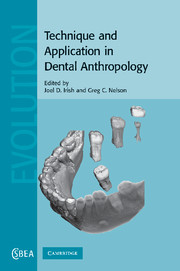Book contents
- Frontmatter
- Contents
- Contributors
- Acknowledgments
- Section I Context
- Section II Applications in assessing population health
- Section III Applied life and population history
- 9 Charting the chronology of developing dentitions
- 10 Dental age revisited
- 11 Primate dental topographic analysis and functional morphology
- 12 Forensic dental anthropology: issues and guidelines
- 13 Inter- and intra-specific variation in Pan tooth crown morphology: implications for Neandertal taxonomy
- 14 The quantitative genetic analysis of primate dental variation: history of the approach and prospects for the future
- Section IV Forefront of technique
- Index
- References
13 - Inter- and intra-specific variation in Pan tooth crown morphology: implications for Neandertal taxonomy
Published online by Cambridge University Press: 12 September 2009
- Frontmatter
- Contents
- Contributors
- Acknowledgments
- Section I Context
- Section II Applications in assessing population health
- Section III Applied life and population history
- 9 Charting the chronology of developing dentitions
- 10 Dental age revisited
- 11 Primate dental topographic analysis and functional morphology
- 12 Forensic dental anthropology: issues and guidelines
- 13 Inter- and intra-specific variation in Pan tooth crown morphology: implications for Neandertal taxonomy
- 14 The quantitative genetic analysis of primate dental variation: history of the approach and prospects for the future
- Section IV Forefront of technique
- Index
- References
Summary
Introduction
The taxonomic position of Neandertals plays a central role in the debate over modern human origins. In the past decade, the focus of this debate has shifted from strict interpretations of the two polarized sides (e.g. out of Africa vs. multiregional evolution) to interpretations that incorporate more (substantial) or less (trivial) gene flow between modern humans and their archaic predecessors. Nonetheless, paleoanthropologists from the two “camps” are still divided on whether or not Neandertals should be considered their own species, Homo neanderthalensis. Generally speaking, supporters of the replacement model (i.e. out of Africa) view Neandertals as a distinct species (Harvati, 2003; Rak, 1986; Schwartz and Tattersall, 1996; Stringer, 1996), whereas supporters of continuity models (i.e. multiregional evolution, assimilation, etc.) view Neandertals as a racial variant or sub-species of Homo sapiens (Frayer et al., 1993; Smith et al., 1989; Wolpoff et al., 1994). Whether or not Neandertals and modern humans were distinct species (Homo neanderthalensis and Homo sapiens, respectively) has implications regarding the significance of gene flow and continuity between archaic and modern Europeans.
Recent genetic research has provided new insight into this problem. Studies of mitochondrial DNA (mtDNA) have shown that: (1) substantial differences distinguish Neandertal from contemporary human mtDNA (Krings et al., 1997, 1999, 2000; Ovchinnikov et al., 2000), (2) regional affiliation between Neandertal mtDNA and that of living Europeans is lacking (Krings et al., 2000; Ovchinnikov et al., 2000), and (3) Neandertal mtDNA cannot be found in modern humans (Serre et al., 2004).
- Type
- Chapter
- Information
- Technique and Application in Dental Anthropology , pp. 293 - 316Publisher: Cambridge University PressPrint publication year: 2008
References
- 4
- Cited by



